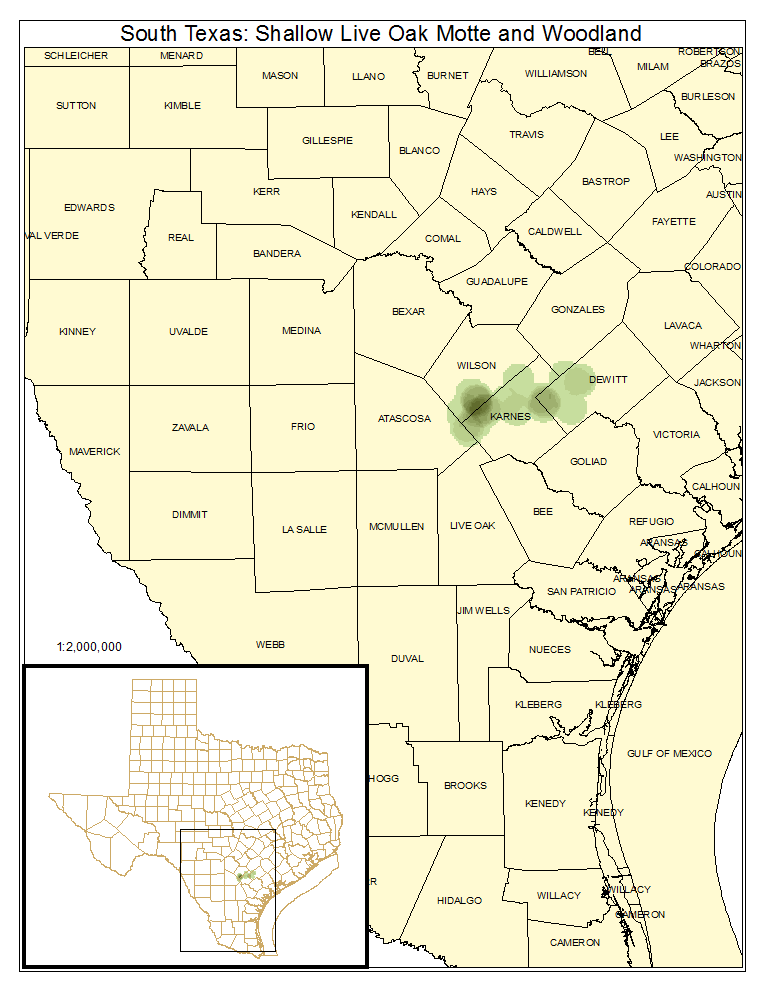Tamaulipan Calcareous Thornscrub
Geology
Ridge or plateau forming hard calcareous substrates such as caliche of the Goliad Formation or Uvalde Gravel.
Landform
Typically ridges high on the landscape, sometimes rolling or relatively level plateaus.
Soils
Shallow, Shallow Ridge or Gravelly Ridge Ecological Sites.
Parent Description
This shrubland typically occupies xeric, rocky uplands on calcareous substrates including limestone, caliche (such as those of the Goliad Formation), calcareous gravels, and calcareous sandstone of south Texas and northeastern Mexico. Soils are usually thin, and sites are most frequently dominated by shrubs between 0.5 and 2 m in height. Shrub canopy can be dense (to about 90%), or sparser where rocky exposures reduce substrate for rooting. A sparse overstory, usually <4 m in height, may be present and composed of species such as Prosopis glandulosa (honey mesquite) and, in the south, Ebenopsis ebano (Texas ebony), Cordia boissieri (anacahuita), and/or Helietta parvifolia (baretta). Quercus fusiformis (plateau live oak) may form a relatively open canopy in areas in the northeastern part of the South Texas Plains. The shrub layer may be heavily dominated by Leucophyllum frutescens (cenizo), Acacia berlandieri (guajillo), and/or Acacia rigidula (blackbrush). More commonly, a diverse array of shrubs is present, including these three in addition to several of the following species: Salvia ballotiflora (shrubby blue sage), Eysenhardtia texana (Texas kidneywood), Guaiacum angustifolium (guayacan), Sophora secundiflora (Texas mountain-laurel), Mahonia trifoliolata (agarito), Ephedra antisyphilitica (joint-fir), Sideroxylon celastrinum (la coma), Jatropha dioica (leatherstem), Bernardia myricifolia (oreja de raton), Karwinskia humboldtiana (coyotillo), Aloysia macrostachya (vara dulce), Condalia spathulata (knifeleaf condalia), Croton incanus (Torrey croton), Koeberlinia spinosa (allthorn), Acacia schaffneri (huisachillo), Forestiera angustifolia (desert olive), Celtis ehrenbergiana (granjeno), Diospyros texana (Texas persimmon), Cylindropuntia leptocaulis (tasajillo), Krameria ramosissima (calderona), Yucca treculeana (Spanish dagger), and others. More southerly occurrences may also contain Lippia graveolens (redbrush lippia), Helietta parvifolia (baretta), Gochnatia hypoleuca (chomonque), Croton humilis (low croton), Ebenopsis ebano (Texas ebony), and/or Mortonia greggii (afinador). The herbaceous layer may be somewhat well-developed, but often bare rock is easily visible through the layer. Many sites are now dominated by non-native grasses, particularly Bothriochloa ischaemum var. songarica (King Ranch bluestem) and/or Pennisetum ciliare (buffelgrass). Other grasses are often shortgrasses, with species such as Bouteloua rigidiseta (Texas grama), Bouteloua hirsuta (hairy grama), Bouteloua dactyloides (buffalograss), Hilaria belangeri (curlymesquite), Aristida purpurea (purple threeawn), Bouteloua curtipendula (sideoats grama), and Setaria leucopila (plains bristlegrass) present. Forbs and subshrubs are conspicuous in the herbaceous layer and include species such as Tiquilia canescens (oreja de perro), Thamnosma texana (Texas desert-rue), Galphimia angustifolia (narrowleaf thryallis), Polygala alba (white milkwort), Cordia podocephala (cluster cordial), Acourtia runcinata (peonia), Dalea aurea (golden dalea), Calliandra conferta (Rio Grande stickpea), Chamaecrista greggii (Gregg's senna), Heliotropium torreyi (Torrey heliotrope), Melampodium cinereum (blackfoot daisy), Hymenopappus scabiosaeus (old plainsman), Desmanthus velutinus (velvet bundleflower), Calylophus hartwegii (Hartweg evening primrose), Simsia calva (awnless bush sunflower), Hermannia texana (Mexican mallow), Macrosiphonia lanuginosa var. macrosiphon (plateau rocktrumpet), Viguiera stenoloba (skeletonleaf goldeneye), Stenaria nigricans (prairie bluets), Thymophylla pentachaeta (fire-hair dogweed), Wedelia hispida (hairy zexmania), and Meximalva filipes (violet sida). Down slope from these sites, soil development increases, soils tend to be tight, a more well-developed overstory of Prosopis glandulosa (honey mesquite) becomes prominent, and species such as Castela erecta (amargosa) and Ziziphus obtusifolia (lotebush) increase in cover relative to other species.
Ecological Mapping Systems
South Texas: Shallow Live Oak Motte and Woodland
Sites in the northern part of the South Texas Plains where Quercus fusiformis (plateau live oak) dominates the overstory. Various shrub species of the system may dominate the understory.
Distribution Map

Public Land Occurrence
- None.
South Texas: Shallow Shrubland
Typical shrublands of ridges and caliche plateaus with moderate shrub cover and sometimes a sparse overstory canopy.
Distribution Map

Photos

Public Land Occurrence
- Amistad National Recreation Area: US National Park Service
- Chaparral Wildlife Management Area: Texas Parks & Wildlife Department
- Devil's River State Natural Area: Texas Parks & Wildlife Department
- Kickapoo Cavern State Park Area: Texas Parks & Wildlife Department
- Lake Casa Blanca State Park: Texas Parks & Wildlife Department
- Lake Corpus Christi State Park: Texas Parks & Wildlife Department
- Lower Rio Grande Valley National Wildlife Refuge: US Fish and Wildlife
South Texas: Shallow Dense Shrubland
Dense shrublands often dominated by species such as Acacia rigidula (blackbrush), Leucophyllum frutescens (cenizo), and Acacia berlandieri (guajillo).
Distribution Map

Photos

South Texas: Shallow Sparse Shrubland
Sites on calcareous ridges and plateaus where shrub canopy is sparse. These sites are often managed pasture, with species such as Pennisetum ciliare (buffelgrass), Bothriochloa ischaemum var. songarica (King Ranch bluestem), or Cynodon dactylon (bermudagrass).
Distribution Map
